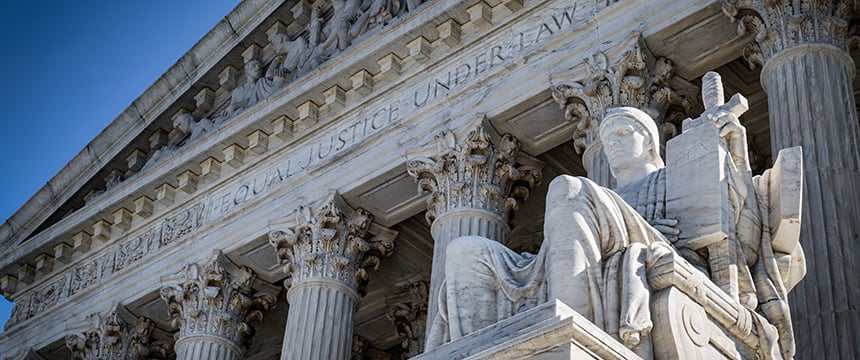U.S. Supreme Court Rules That “Pure Omissions” Are Not Actionable Under Rule 10b-5
Court rejects failure to disclose information required under Regulation S-K Item 303 as basis for Rule 10b-5 claim, holds that unlike “half-truths,” “pure omissions” are not actionable under Rule 10b-5

On April 12, 2024, the United States Supreme Court delivered an important decision on the issue of whether a failure to make disclosure required under Item 303 of Regulation S-K can support a Rule 10b-5 claim, even in the absence of an otherwise-misleading statement. In Macquarie Infrastructure Corp. v. Moab Partners,[1] the Court concluded that it could not, holding that “pure omissions are not actionable under Rule 10b-5(b).”[2] The decision resolved a circuit split between the Second Circuit, which had held that a Reg S-K Item 303 violation alone could give rise to liability under Rule 10b-5, and the Third, Ninth, and Eleventh Circuits, which had each held it could not.
Section 10(b) of the Securities Exchange Act of 1934 makes it “unlawful for any person . . . [t]o use or employ, in connection with the purchase or sale of any security . . . [,] any manipulative or deceptive device or contrivance in contravention of such rules and regulations as the [SEC] may prescribe.” The Court has recognized an implied private right of action under this section.
Rule 10b-5, the enabling rule of Section 10(b), in turn makes it unlawful for public companies to “make any untrue statement of a material fact or to omit to state a material fact necessary in order to make the statements made, in the light of the circumstances under which they were made, not misleading.”[3]
Reg S-K Item 303 requires issuers to describe, in certain SEC filings, “known trends or uncertainties that have had or that are reasonably likely to have a material favorable or unfavorable impact” on the issuer’s financial performance.
The question in the case was whether the omission of disclosures alleged to be required under Reg S-K Item 303 was enough, standing alone, to give rise to liability under Rule 10b-5.
The case was based on an alleged omission from Macquarie Infrastructure Corp.’s SEC filings. Macquarie operates liquid storage terminals that handle petroleum and other oil products. One of those products was a high-sulfur fuel oil that was the byproduct of the refining process. A UN regulation adopted in 2016 introduced a ban on this type of high sulfur fuel oil in shipping in 2020. Having failed to disclose in its SEC filings the potential effect of this UN action on its operations, Macquarie first announced a significant decline in its business due to a structural decline in this part of the fuel market in February 2018, causing its stock price to drop 41%. Shareholder suits followed.
Moab, a Macquarie shareholder, alleged that Macquarie was obligated under Reg S-K Item 303 to disclose that the UN ban on high-sulfur fuel would have a substantial effect on its operations. This omission, Moab argued, was actionable under Rule 10b-5.
In considering the applicable language of Rule 10b-5(b) at issue — prohibiting omission of a material fact necessary “to make the statements made . . . not misleading” — the Court differentiated between “pure omissions” and “half-truths.” The Court described a “pure omission” as a speaker saying nothing, where silence has no particular meaning under the circumstances. Half-truths, on the other hand, are statements that “omit critical qualifying information.”[4] In a vivid example, the Court described the difference between a pure omission and a half-truth as “the difference between a child not telling his parents he ate a whole cake and telling them he had dessert.”[5]
The Court held that Rule 10b-5(b) covers half-truths but “does not proscribe pure omissions.”[6] The Court reasoned that the words “in order to make the statements made . . . not misleading” require some antecedent statement in order to make sense.[7] The Court found support by comparing Rule 10b-5(b) to the language in Section 11(a) of the Securities Act, which prohibits registration statements from containing “an untrue statement of a material fact or omit[ing] to state a material fact required to be stated therein or necessary to make the statements therein not misleading.”[8] Section 11(a) contains language that expressly prohibits pure omissions, but Rule 10b-5(b) and Section 10(b) of the Exchange Act do not.
While this decision may not have been surprising to practitioners who follow the Court, it will undoubtedly shape the Rule 10b-5 battle front between issuers and plaintiffs’ attorneys going forward. The Second Circuit, which covers New York, is a busy circuit for securities cases, and, according to data compiled by Stanford Law School, during the period 2014 and 2022, between 11% and 26% of Rule 10b-5 cases in the Second Circuit pursued a Reg S-K Item 303 theory each year.[9] However, in footnote 2 of the Court’s decision, the Court noted that the decision did not address an ongoing dispute between the parties as to whether the statements at issue were indeed “pure omissions,” as opposed to “half-truths.” This could be an indication of where the battlefront between issuers and plaintiffs’ attorneys may be heading. It is also worth noting that Rule 10b-5 claims based on half-truths, as well as disclosure violations based on other sections of federal securities laws, remain unaffected by the decision.
If you have questions about Rule10b-5 or related Court decisions, please contact any of the authors of this article or your Foley & Lardner attorney.
To read all Foley Corporate Governance Updates, click here.
[1] Macquarie Infrastructure Corp. v. Moab Partners, 601 U.S. ___, (U.S. April 12, 2024).
[2] Id. at 1.
[3] 17 CFR § 240.10b-5(b).
[4] Macquarie, slip op. at 5 (quoting Universal Health Services, Inc. v. United States ex rel. Escobar, 579 U.S. 176, 188 (2016)).
[5] Id.
[6] Id.
[7] Id.
[8] Id. at 6 (quoting 15 U.S.C. §77k(a)).
[9] Petition for Certiorari, Appendix at 62a.


